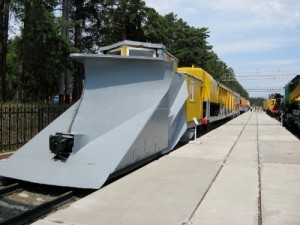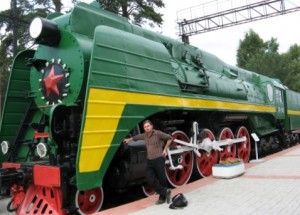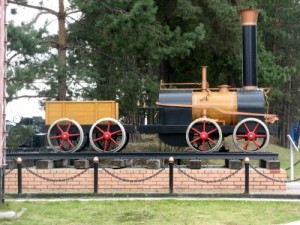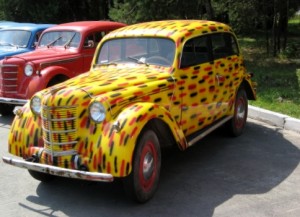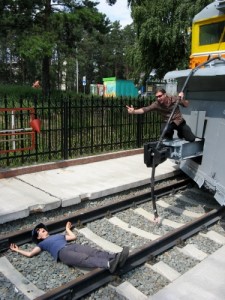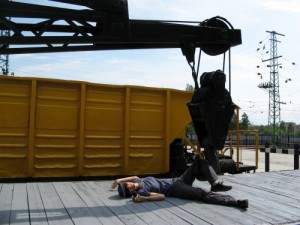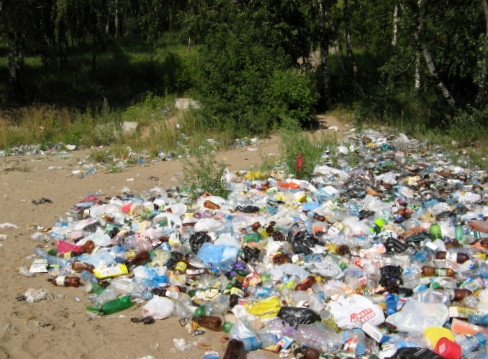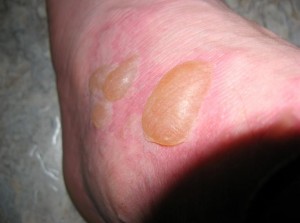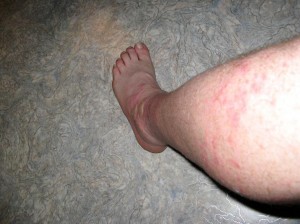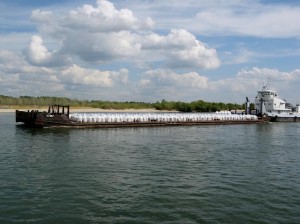In the morning I feel fairly normal again, a little tired, but coherent and very thankful to Vortex Yulia and her family for looking after me through what could have been a terrible episode. Her parents both ask how I’m feeling and I am so much better than yesterday. The fever has gone, but the blisters have, to my amazed horror, joined together to form a superblister twice the size of yesterday’s. I’m now quite happy we didn’t spend Monday night on a bus into Altai; Tuesday would have been a complete nightmare for me. I discover that Oleg had a breakout of similar blisters after clearing a vine like weed from a corner of the dacha. He ended up needing an anti-histamine injection to calm the symptoms. As this is sinking in, Don arrives with Yana in an excited state.
“I’ve learned the best word!”
“Oh what is it?”, I ask curiously.
“Zapoi!”
Vortex Yulia looks up and says,
“Oh, you saw the Barber of Siberia with Yana yesterday didn’t you?”
“Yes. It was great. But the best part was this word.”
“So what does it mean?”, I entreat.
“It means to go on a big bender for days on end.”
“Well, many days, maybe a week”, Yulia adds.
“Well, that word should come in handy then”, I say with a smile.
Yulia looks at me suddenly,
“Why are all the Russian words you learn so shocking?”
“Because they’re the fun ones.”
We decide the major mission of the day is to visit Akademgorodok and the nearby Ob Sea to scout for good eclipse viewing locations. There’s also a train and automobile museum to check out on the way; so we launch ourselves into the wilderness in search of another marshrutka. Akademgorodok, the ‘Academic City’, whilst considered a part of Novosibirsk, was created to be a town that brought together Soviet Russia’s greatest minds. Situated in a beautiful forest by the Ob Sea, the location is beautiful in its own right and was intended to provide the best environment for academics, scholars and researchers to work in many different fields for the benefit of the country. In Soviet times the residents here enjoyed a higher standard of living than most Russians, having access to more foreign goods and foodstuffs, with even more freedoms given to the more qualified and established researchers. It did suffer an almost fatal collapse in the early 90s with the end of the Soviet Union, but private investment has worked to bring some life back. Today it is home to the Novosibirsk State University, more than thirty technical research institutes and an agricultural and medical academy. Its position next to the Ob Sea is also somehow poetic, since this is an artificial sea created by the damming of the Ob River for the creation of Novosibirsk’s hydroelectric power station.
We arrive at the train museum to find an amazing array of locomotives, carriages and specialist wagons lined up on four sets of rails running for a hundred metres or so. All have been lovingly painted and generally appear to be in good enough condition to roll back into service tomorrow; although I doubt they really are. There are quite a few signs displayed, in Russian, to mark the 170 year history of trains in the country, from 1837 to 2007. Russia had indeed been an early adopter of the technology, sending engineers to England to bring back the machines and ideas to build their own fleet to cross the country. It wasn’t until the end of the 19th century that construction began on the Trans-Siberian line I was now in the process of 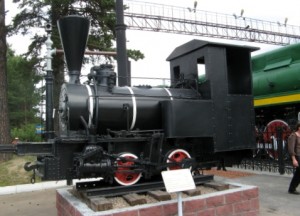
 crossing, but by that time they already had a network of lines in western Russia. We wander around steam locomotives, diesel engines, the last Tsar’s passenger carriage before passing by a host of curious wagons featuring cranes, tanks and one with a special suspension arrangement for carrying dangerous fragile goods. My favourite was probably the snow clearing train which combines a massive plough arrangement along with ice cutting and grinding equipment to be able to clear a line buried under the harsh Russian winter. It’s hard to picture it in use on this balmy summer day and after our acrobatics climbing engines and carriages for photo opportunities, we head to the final section that features an array of Russian cars from the last fifty years or so.
crossing, but by that time they already had a network of lines in western Russia. We wander around steam locomotives, diesel engines, the last Tsar’s passenger carriage before passing by a host of curious wagons featuring cranes, tanks and one with a special suspension arrangement for carrying dangerous fragile goods. My favourite was probably the snow clearing train which combines a massive plough arrangement along with ice cutting and grinding equipment to be able to clear a line buried under the harsh Russian winter. It’s hard to picture it in use on this balmy summer day and after our acrobatics climbing engines and carriages for photo opportunities, we head to the final section that features an array of Russian cars from the last fifty years or so.
The cars range from standard commercial Ladas to half-track military vehicles complete with empty rocket launchers. There were even some classic 60s and 70s cars replete with paint jobs that would not look out of place amidst a congregation of hippies in painted VW Beetles. Now we just have to find some that still actually work to start our new world breaking business bringing Russian classic cars to the world. With our new business plan in mind, we make our way to a shop for drinks and ice-creams to allow us to begin important business discussions. And combat the increasingly intense heat. Sweating in Siberia is becoming a habit.
The shop is air-conditioned and we’re happy to pretend to look along all the shelves as we slowly cool down. We choose some ice-creams none of us have ever heard of before and sip at fruit juice wondering how we should line up; a new challenge for we amateur Russian queuers. It turns out this shop sells beer from a series of kegs placed along one wall. All you need is a plastic bottle, or you can buy one, and you can walk away with some cheap, but generally good microbrewed (maybe homebrewed) beer. The man and woman behind the counter are engaged in a disjointed discussion with two middle aged Russian men wearing classic Russian sailor shirts. Neither of these men can actually stand still or up straight and they seem to be heavily refreshed already. It’s midday. The shopkeepers are trying to decide between sending them away or selling them some more beer first. They finally decide to sell them beer first and the man behind the counter emerges to operate the keg tap. The woman waves us over to another section of the counter and our queuing dilemma is solved. She looks a little embarrassed by the behaviour of the two men, which becomes deeper as she discovers we’re Australian tourists. She explains they’re local characters and fathers of people they know. We aren’t terribly bothered by the scene at all; the men aren’t aggressive, just drunk and single-mindedly pursuing the opportunity to acquire more beer. We hang around inside the door to the shop as the men leave, they smile and bid us farewell; clutching their two litre bottles of beer in blissful
happiness.
The ice-cream I pick is delicious. It’s more like a soft creamy cheese, laced with shavings of chocolate that melt gently in your mouth; delivering a smooth textured taste sensation. Don and Lari have quite different kinds, an ice-confection lolly type and a waffle cone style; and all are good. I can certainly vouch for the Russian ice-cream cabinet in any shop, you won’t recognise much, just pick one with a cool label and enjoy the discovery. We sit at the train station deciding if we’ll get back on the bus or try and 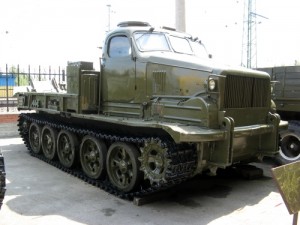 catch the train. I have no energy or enthusiasm to talk to ticket window women, so we jump on the next marshrutka.
catch the train. I have no energy or enthusiasm to talk to ticket window women, so we jump on the next marshrutka.
We arrive in the Akademgorodok and realise we have no idea what to do there, apart from visiting the Ob Sea. We buy some Kvas from one of the ever-present street vendors before I consult the map I have in a guidebook. I then boldly stride down a dirt pathway leading through a pine forest towards the sea itself. After walking through some rather beautiful temperate forest for about twenty minutes, we realise we can’t possibly be heading in the right direction. A number of people have passed us walking the other way, which gave us confidence, but now it seems to be taking far too long to walk the expected kilometre. I was so sure at the start, but probably should have left navigation to people more fully in command of their senses. We come to a train line and stop while Don consults the guidebook to establish we’ve headed off at 90 degrees to the right direction. So we return through the forest back to the bus station and try again.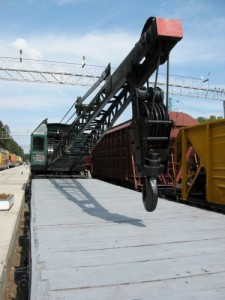
We stroll through another stretch of beautiful forest, tall pine trees tower above us providing welcome shade. The green undergrowth is lush with beautiful ferns and shrubs and replete with discarded cans, bottles, chip packets and paper. We comment on the continued lack of environmental awareness and care; a beautiful forest brought low by thoughtless litter. This time we cross a road and continue down the pathway until we begin to hear gentle waves against a shoreline. We are all utterly unprepared for the astounding pile of rubbish that forms a strange kind of gateway to the beach. The forest pathway splits in two and turns into sand at the top of the beach. Between the two pathways there is a triangular pile of rubbish about fifteen metres long, about ten metres wide and generally about thirty to forty centimetres deep. Along the sides of both pathways there are lines of rubbish as well, but not quite as fantastic as the centrepiece. It’s made up largely of glass beer bottles, plastic two litre beer bottles (looking like the ones from the shop we just visited), soft drinks, chip packets, cigarette packets and an array of other general refuse. The three of us look at each other and at the pile in utter disbelief. We’ve all just decided separately that we aren’t going to be seeing the eclipse here.
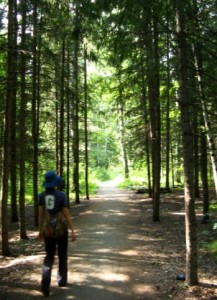
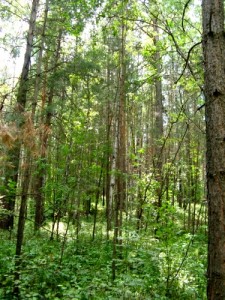 We look along the beach to see quite a lot of people strung along the curved bay. The groups stretch either side of a large stage area being prepared for a rock music festival to be held here on the day of the eclipse. We had been interested in the festival idea, but Vortex Yulia warned us to be careful at it, there would be pickpockets in abundance looking for tourists. The general scene doesn’t fill us with enthusiasm as we sit on a piece of scrap iron on the beach and finish our water. We watch a middle aged guy further down the beach trying to impress some young women. He’s prancing around on the water’s edge for a while, then jogs up the beach and returns in his 4WD. He parks it half in the water and stands in front of it posing for them. We crack up laughing and decide to stay for a while to watch the car sink into the waterlogged sand and become bogged. We watch the tyres begin to sink into the sand, then decide the amusement will take too long and we had better start heading back into the city.
We look along the beach to see quite a lot of people strung along the curved bay. The groups stretch either side of a large stage area being prepared for a rock music festival to be held here on the day of the eclipse. We had been interested in the festival idea, but Vortex Yulia warned us to be careful at it, there would be pickpockets in abundance looking for tourists. The general scene doesn’t fill us with enthusiasm as we sit on a piece of scrap iron on the beach and finish our water. We watch a middle aged guy further down the beach trying to impress some young women. He’s prancing around on the water’s edge for a while, then jogs up the beach and returns in his 4WD. He parks it half in the water and stands in front of it posing for them. We crack up laughing and decide to stay for a while to watch the car sink into the waterlogged sand and become bogged. We watch the tyres begin to sink into the sand, then decide the amusement will take too long and we had better start heading back into the city.
On the way back to town we receive a call from Yana, telling us where to meet her to go to the conversational English class we are attending this evening. On the way there, we pass a table that’s appeared on the side of the street selling eclipse merchandise. We need some eclipse glasses to watch the moon crossing in front of the sun before Totality happens. During Totality you don’t need them anymore, you can enjoy the black sun with the naked eye. Lari picks up a set at looks through them. There are scratch marks on the lenses that mean it won’t be safe to use them to look at the sun; you can’t afford any naked light at all to pass through them. We spend a while looking through a lot of them and they all seem to suffer the same problem. I’m thinking about buying one of the fridge magnet souvenirs when Don notices another table nearby selling the same type of things. Before we make it to our destination we pass another five of these stands and finally find one with eclipse glasses that aren’t scratched. The stands all appeared like a sudden virus this afternoon and we wonder what local organisation is profiting from the eclipse, since all of them sell the same kit. As we leave the last one Don looks at the stand gently shaking his head,
“Eclipse badges, shirts, glasses, fridge magnets….you know you’re outside Australia because there are no stubbie coolers.”
Province of Novosibirsk, Russia, 630000


